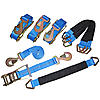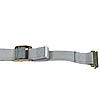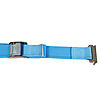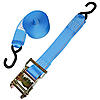4 Axle, 4 Ratchet Straps Cambuckle 3,000 lbs BS Cambuckle 3,000 lbs BS Cambuckle 3,000 lbs BS Webbing 6,000 lbs BS

What are Safe Working Load Limit Ratings?
A Safe Working Load Limit Rating tag can be found on every tie-down strap in the United States. Working Load Limit Ratings were designed to take the breaking strength or ultimate point until failure and divide that number by three. For example, a 10,000 lbs breaking strength would have a safe assembly working load limit rating of 3,335 lbs.
Working Load Limit Ratings were designed to prevent tie-down straps securing cargo from being pushed past their breaking points which could cause the cargo to come undone or move out of place while on the road. Working Load Limit Ratings are required by the Department of Transportation (DOT) on all tie-down straps used for cargo control securement applications in the United States.
Working Load Limits (WLL) also help users easily pair tie-down straps with the ideal strap that is safely rated for the weight of their cargo control application. Both tie-down straps and transport chains are required to use working load limit ratings for all cargo control securement applications. When straps and binder chains are improperly paired with the weight of the cargo the cargo becomes at risk of falling off of the trailer or becoming unsecured.

Why are Safe Working Load Limit Ratings Important?
Before the use of working load limit ratings breaking strengths or the ultimate point until failure were used and often led to tie-down straps breaking, cargo becoming unsecured, and injuries. The one thing that breaking strengths can not account for is a hard brake, going too fast around a corner, or a rapid acceleration which can all cause momentarily stress and strain on your load and can be incredibly hard to account for.
Working Load Limit Ratings were created to take these factors into account and provide you with a safety net to ensure that your straps are not being pushed past their safety limitations and to help protect your cargo and other motorists on the road from a potentially dangerous situation. The working load limits can easily help you identify if you need to use more tie-down straps or transport chains to keep the cargo safely secured and within the general guidelines for cargo control with the Department of Transportation (DOT).
There are harsh fines and penalties set in place by the Department of Transportation that vary for each state for those who do not follow the Department of Transportation’s general guidelines for cargo control. You can view the full general guidelines by visiting our page with the Full General Cargo Control Guidelines
How Are Working Load Limit Ratings Determined?
Working Load Limit Ratings are calculated by taking the overall breaking strength of the cargo control product you are using such as tie-down straps or transport chains. Once the ultimate point of failure has been stress tested you take the ultimate breaking strength point such as 10,000 lbs for example and divide that number by three parts. This provides you with the safe assembly working load limit of the cargo control product that you are using.
If you are purchasing tie-down straps in the United States it is required to be sewn onto the straps directly or stenciled onto the polyester tie-down webbing for easy visibility. If you are using a Grade 70 (G70) transport chain you can find that every 7th chain link is stamped with the grade of chain that is being used to stay in compliance with the cargo control general guidelines.
If you are using a product that does easily and visibly show the working load limit rating you are at extreme risk of facing fines and penalties from the Department of Transportation. As well as potentially using a product that is unsafe to use as it puts your cargo and other motorists’ safety at risk. If you find a tie-down strap or chain that is not labeled you should immediately cease using the product as it can put yourself and others in danger.

Shop Our Popular Tie Down Straps
Assembly 3,335 lbs WLL
Assembly 915 lbs WLL
Assembly 915 lbs WLL
Assembly 915 lbs WLL
Assembly 915 lbs WLL

Frequently Asked Working Load Limit Questions
Is it Okay to Exceed the Working Load Limit Rating? – No, you should never exceed the safe working load limit (SWL) of any cargo control product. You should instead either use more tie-down straps or a heavier-duty strap when possible to ensure you and your cargo remain safe while on the road.
Does Heavier Duty Tie Down Webbing Make A Higher Working Load Limit? – It depends on the strap combination of parts. In most circumstances, the weakest link of the strap tends to be the webbing but in straps such as e-track straps for example the e-track fitting tends to be the weakest link of the strap and the strap is only as strong as the weakest link causing a lower working load limit rating.
What Should You Do If You Are Close To Exceeding the WLL? – If you are close to exceeding or close to meeting the exact working load limit that your straps or chain is rated for you should strongly consider using more tie down straps or transport chain to create a safety net. The last thing you want to happen is a sudden brake to cause your tie-down straps or transport chain to break and cause your cargo to become unsecured while on the road. If you ever feel uncomfortable securing your load make sure to add additional straps when possible.
How to Understand Safe Working Load Limit Ratings
Published on 03/07/24
A42480S
$83.00
3200077
$6.55
3200089
$7.05
3200094
$7.95
A42461RSH
$8.95








